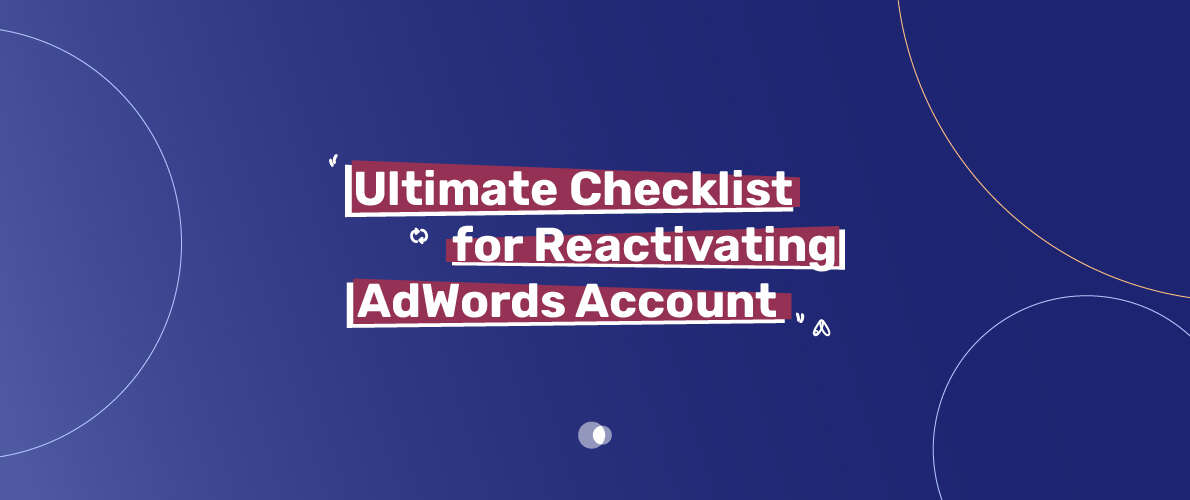Getting your Google Ads account back up and running can seem tough. But with the Checklist for Reactivating AdWords Account, you can streamline the process. This guide ensures you cover all crucial steps to regain control of your ads, boost paid search campaigns, and improve ROI effectively.

Table of Contents
Key Takeaways
- Understand the common reasons for Google Ads account deactivation and follow a Checklist for Reactivating AdWords Account to streamline the process
- Ensure billing information and payment methods are verified for seamless reactivation. As you prepare to advertise on Google
- Review and update your account settings, including campaign settings, geographic targeting, and language preferences.
- Analyze your historical campaign performance data to identify areas for optimization.
- Optimize your keyword and ad group structure to improve the relevance and effectiveness of your campaigns.
- Craft compelling ad copy and leverage ad extensions to enhance your advertising efforts.
- Set up conversion tracking and analytics to measure the success of your reactivated campaigns.
Understanding AdWords Account Status and Reactivation Requirements
As a Google Ads user, staying compliant with policies is crucial. If your account faces issues, a Checklist for Reactivating AdWords Account can guide you through the necessary steps. Additionally, efficient Google Ads management ensures campaigns run smoothly, avoiding policy violations and minimizing disruptions.
Common Reasons for Account Deactivation
AdWords accounts can get deactivated for several reasons:
- Policy violations: Not following Google’s ad policies, like using banned content or fraud, can suspend your account.
- Payment issues: Not paying bills or expired payment methods can also deactivate your account.
- Inactivity: If your account is inactive for too long, Google might suspend it.
Initial Assessment Steps
If your AdWords account is deactivated, the first step in a successful Google Ads Account Suspension Recovery is to identify the root cause. Common issues include policy violations, payment irregularities, or account misrepresentation. Carefully review the feedback or warnings provided by Google to pinpoint the problem.
Reach out to Google’s support team for clarification if needed, and address the identified issues promptly. For example, this might involve updating your ad content to comply with policies or resolving billing disputes.
Having a reliable Google Ads agency account can also simplify the recovery process. Agencies often have the expertise to navigate Google’s policies, submit appeals effectively, and ensure long-term compliance, reducing the risk of future suspensions.
Documentation Requirements
To start the reactivation process, you’ll need certain documents. These include:
- Proof of identity (like a government ID)
- An explanation of why your account was suspended
- Proof you’re following Google Ads policy violations or payment issues
- New billing info and payment methods
Understanding why your account was deactivated and gathering the right documents is essential. With the Checklist for Reactivating AdWords Account, you can efficiently navigate the process, ensuring all necessary steps are covered for a smooth reactivation.
Verifying Your Billing Information and Payment Methods
Keeping your billing details and payment methods up to date is essential for ensuring smooth account management. By collaborating with a Google AdWords company , you can efficiently verify and update payment options like credit card details and invoicing preferences. Following a Checklist for Reactive AdWords Account, this guide streamlines the reactivation process, ensuring it’s hassle-free and effective.
Start by checking your billing details for accuracy. Make sure your contact info, billing address, and any invoices or payments are current. If you spot any errors, fix them right away.
Then, confirm your payment method is good to go. This means checking your credit card’s expiration date and security code. If your card has expired or been replaced, update your AdWords account with the new info.
- Review your billing address and contact information
- Verify your credit card details, including expiration date and security code
- Update any outstanding invoices or payments
- Ensure your payment method is valid and active
Fixing any credit card verification or invoicing issues early on can make the reactivation smoother. By carefully checking and updating your billing info, you’re closer to getting your AdWords account back online.
Accurate billing information is the foundation for a successful AdWords reactivation.
Reviewing and Updating Your Account Settings
To reactivate your AdWords account, you need to check and improve your settings. This makes sure your campaigns match your business goals and follow the latest trends. It helps improve your campaign optimization and results.
Campaign Settings Audit
Start by reviewing your campaign settings as part of the Checklist for Reactivating AdWords Account. Ensure your targeting options, ad scheduling, and device preferences align with your audience and marketing goals. Update any outdated or ineffective settings to optimize performance and get your campaigns back on track efficiently.
Geographic Targeting Review
Then, examine your geographic targeting. See if your current locations are still right. Think about adding or changing your targeting options to better reach your audience. This can really boost your campaign’s success.
Language Preferences Configuration
Finally, check and update your language settings. Make sure your ads and content are in the languages your customers speak. This will help them connect better and improve your campaign optimization.
| Account Setting | Importance | Key Considerations |
| Campaign Settings | High | Review targeting optionsOptimize ad schedulingAdjust device preferences |
| Geographic Targeting | High | Evaluate relevance of current locationsExpand or refine targeting options |
| Language Preferences | Medium | Optimize for languages spoken by target audienceEnhance campaign optimization |
By carefully checking and updating your settings, you can make your AdWords campaigns work better. They will give you better results and a good return on your ad spending.
Checklist for Reactivating Your AdWords Account
If your Google Ads account has been deactivated, don’t worry. You can reactivate it, and this checklist will help you. It covers everything from checking your billing info to optimizing your account settings. Follow these reactivation steps to get back to running your ads.
- First, check the account recovery policy to see if you qualify for reactivation.
- Next, collect all needed documents like ID, payment info, and any Google Ads support emails.
- Make sure your billing info is current and your payment methods are valid.
- Then, review and update your account settings. This includes campaign details, where you want to show ads, and language.
- Look at your past campaign data to find ways to improve and optimize.
- Organize your keywords and ad groups to match your current marketing goals.
- Create engaging ad copy and use ad extensions to make your ads stand out.
- Finally, set up conversion tracking and analytics to track your Google Ads checklist performance.
By using this detailed account reinstatement checklist, you’ll be on the right path to reactivating your AdWords account. Remember, patience and careful attention are crucial during this process.
| Reactivation Step | Description |
| Review Account Recovery Policy | Learn what you need to do to reactivate your AdWords account. |
| Gather Necessary Documentation | Get your ID, payment info, and any Google Ads support emails ready. |
| Update Billing Information | Check that your payment methods are current and valid. |
| Review and Update Account Settings | Adjust your campaign settings, targeting, and language preferences. |
| Analyze Historical Campaign Performance | Use your past data to find ways to improve and optimize. |
| Restructure Keywords and Ad Groups | Make sure your keywords and ad groups align with your marketing goals. |
| Craft Compelling Ad Copy and Extensions | Create engaging ad content and use effective ad extensions. |
| Set Up Conversion Tracking and Analytics | Use tracking and analytics to measure your campaign success. |

For a successful AdWords account reactivation, focus on details and follow a strategic plan. This checklist will help you regain control of your ads and achieve your goals.
Analyzing Historical Campaign Performance Data
Looking back at your AdWords campaign history is crucial. It helps you understand what worked and what didn’t. By reviewing key metrics, updating your competitive analysis, and planning your budget, you can make your future campaigns better. They will also meet your business goals more effectively.
Key Performance Metrics Review
Begin by checking your campaign’s past data. Look at important metrics like click-through rate (CTR), conversion rate, cost-per-click (CPC), and return on ad spend (ROAS). This will show you where to improve and guide your efforts.
Competitor Analysis Updates
- Update your research on competitors’ AdWords campaigns.
- Study their ad copy, targeting, and bidding to find ways to beat them.
- Keep an eye on industry trends that could change your budget optimization and performance analysis.
Budget Allocation Strategy
Use your KPIs and competitive insights to plan your budget. Put more money into your best campaigns and ad groups. Cut back on the ones that don’t do well. This will help you get the most out of your return on investment (ROI) and optimize your budget better.
“Successful campaign reactivation is all about learning from the past and applying those insights to create a more effective future strategy.”
Optimizing Keywords and Ad Groups Structure
Effective keyword and ad group management is key to a successful AdWords campaign. By refining your keyword lists and structuring your ad groups well, you can target better. This improves relevance and boosts campaign performance.
Refine Your Keyword Research
Begin by reviewing your current keyword lists. Look at their performance, search volume, and how well they match your business. Find keywords that lead to good conversions and those that don’t. Also, look for new keywords that fit your campaign goals and audience.
- Analyze current keyword performance to identify high-performing and low-performing terms
- Expand your keyword research to find new, relevant keywords that can improve targeting
- Leverage keyword research tools to uncover additional keyword opportunities
Organize Ad Groups for Maximum Relevance
Organize your ad groups to match your keywords, ad copy, and landing pages closely. Group similar keywords together. This helps you create focused ad groups with relevant and compelling messages.
- Group keywords by theme or product/service category
- Ensure ad copy and landing pages closely match the keywords in each ad group
- Continuously refine and optimize your ad group structure based on performance
Implement Negative Keywords to Improve Targeting
Negative keywords are vital for better targeting and avoiding irrelevant searches. Add negative keywords to your campaigns to exclude searches that won’t lead to conversions.
| Keyword Match Type | Description | Example Negative Keywords |
| Broad Match Negative | Excludes searches containing the keyword in any order, along with closely related variations | free, cheap, discount |
| Phrase Match Negative | Excludes searches that contain the exact keyword phrase in the specified order | “free shipping”, “sale price” |
| Exact Match Negative | Excludes searches that exactly match the specified keyword | [free trial], [discount code] |
Optimizing your keywords, ad group structure, and negative keywords can greatly enhance your AdWords campaign’s relevance and performance.

Crafting Compelling Ad Copy and Extensions
In the fast-paced world of digital ads, your ad copy and ad extensions can make or break your campaign. By focusing on great ad content and using ad extensions wisely, you can boost your click-through rates (CTR). This leads to more people visiting your website.
Ad Copy Best Practices
Writing effective ad copy is an art that needs to understand your audience well. To make your ad copy stand out, follow these tips:
- Emphasize what makes your product or service special
- Use simple, clear language that speaks to your audience
- Include relevant keywords to get found in searches
- Use emotions to create a sense of urgency or desire
- Test different versions of your ad copy to find the best one
Extension Options and Implementation
Ad extensions add extra details to your ads, offering users more information about your services or products. By utilizing a Checklist for Reactivating AdWords Account, you can ensure you implement the right extensions, such as sitelinks, callouts, and structured snippets. These features not only enhance the user experience but also improve ad visibility and conversion potential, making them a crucial part of a successful reactivation and campaign strategy.
- Sitelink Extensions – Link to specific pages on your website
- Callout Extensions – Highlight unique features or benefits
- Review Extensions – Display positive customer reviews
- Location Extensions – Show your business address and directions
Mobile Optimization Strategies
With more people using mobile devices, it’s key to make your ads work well on smaller screens. Here are some tips for mobile ad optimization:
- Write concise, easy-to-read ad copy for mobile
- Choose the most important ad extensions for mobile
- Make sure your landing pages work well on mobile
- Use ad formats that are made for mobile, like carousel ads
By following these tips for ad copy, extensions, and mobile optimization, you can create a strong digital ad strategy. Incorporating a Checklist for Reactivating AdWords Account into your workflow will ensure you address key aspects of account setup and campaign optimization. This not only improves your CTR but also boosts your overall campaign performance, setting the foundation for long-term advertising success.
| Extension Type | Potential Benefits |
| Sitelink Extensions | Increase visibility, provide additional information, and direct users to specific pages on your website. |
| Callout Extensions | Highlight unique selling points, features, or benefits that set your product or service apart from the competition. |
| Review Extensions | Leverage positive customer feedback to build trust and credibility, leading to higher CTR improvement. |
| Location Extensions | Provide users with your business address and directions, making it easier for them to visit your physical location. |
Setting Up Conversion Tracking and Analytics
Accurate conversion tracking and analytics are essential elements of any Checklist for Reactivating AdWords Account. By setting up effective tracking and linking your account with Google Analytics, you can gain a comprehensive understanding of your campaign performance.
This allows you to analyze customer behavior, assess the effectiveness of individual campaign elements, and make informed decisions to optimize results. These insights are invaluable in aligning your advertising efforts with your business goals, ensuring your AdWords campaigns achieve maximum efficiency and ROI.
First, set up conversion tracking for your website. This captures important actions like form submissions, purchases, or contact requests. This data helps you improve your ad targeting, ad content, and how you spend your budget. Link your AdWords account with Google Analytics to access powerful reporting tools. These tools help you find valuable insights and make smart decisions based on data.
Next, as part of your Checklist for Reactivating AdWords Account, set clear goals in your analytics platform. Identify key performance indicators (KPIs) like leads, revenue, or return on ad spend that align with your business priorities.
By linking these objectives to your marketing goals, you can effectively monitor your AdWords campaigns’ performance and make data-driven adjustments to optimize results. This strategic alignment ensures your campaigns are not only active but also performing efficiently.
FAQs
What is the process for reactivating a deactivated AdWords account?
To reactivate a deactivated AdWords account, first, understand why it was deactivated. Then, check your billing info and update your account settings. Lastly, review your campaign history to ensure everything is in order.
How do I check the status of my AdWords account?
Log into your Google Ads dashboard to see your account status. If it’s deactivated, you’ll need to fix the issues and follow the reactivation steps.
What documentation is required for the AdWords account reactivation process?
You’ll need to provide proof of identity and valid payment methods. Also, any documents related to why your account was deactivated, like policy violations or payment history.
How do I update my billing information and payment methods in AdWords?
Go to the “Billing” section in your Google Ads account to update your info. Make sure your credit card and invoicing preferences are current and correct.
What should I review in my AdWords account settings during the reactivation process?
Review and update your campaign settings, targeting, and language preferences. This ensures your account is set up right for your marketing goals.
How do I analyze my historical AdWords campaign performance data?
Look at metrics like clicks, impressions, conversions, and cost-per-click (CPC). This data helps you see what’s working and what needs improvement.
What are the best practices for crafting effective AdWords ad copy and using extensions?
Make your ad copy clear and concise, focusing on what makes you unique. Use ad extensions like sitelinks and callouts to make your ads stand out.
How do I set up conversion tracking and integrate Google Analytics with my AdWords account?
To track conversions and link Google Analytics, set up the right tags and codes in both accounts. This helps you measure campaign success and set goals.



